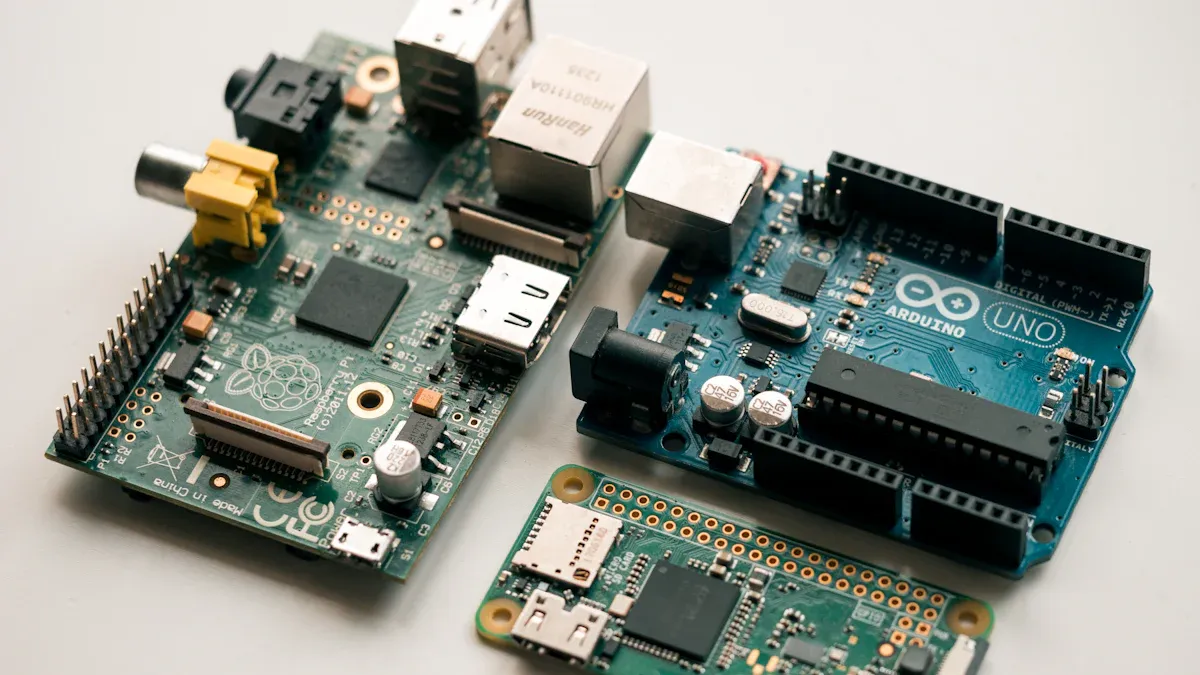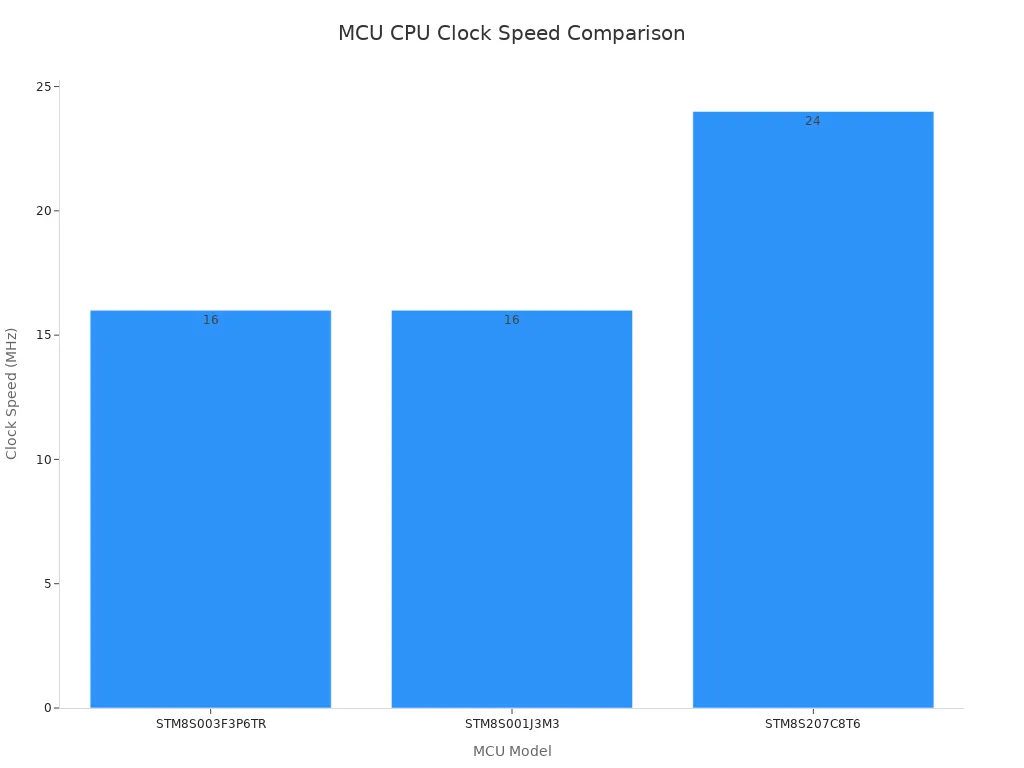STM8S003F3P6TR vs. The Best 8-bit MCUs of 2025

8-bit microcontrollers hold persistent relevance in 2025 for many embedded applications. Their advantages include cost, simplicity, and power efficiency. The market for these devices, valued at $5.23 billion in 2024, projects growth to $9.02 billion by 2033, a 6.7% Compound Annual Growth Rate. This growth comes from increasing demand for low-power, compact, and reliable control solutions. The STM8S003F3P6TR is a prominent and enduring contender in this space. This blog compares the STM8S003F3P6TR against other leading 8-bit MCUs, such as Microchip PIC16F and Atmel AVR ATmega. It helps readers determine the optimal choice for their projects. The comparison covers performance, cost, features, and ecosystem support.
Key Takeaways
8-bit microcontrollers are still important in 2025. They are cheap, simple, and use little power. They are good for many basic electronic devices.
The STM8S003F3P6TR is a strong choice for projects. It is very low cost and tough. It works well for simple tasks and products made in large numbers.
Other top 8-bit MCUs include Microchip PIC16F and Atmel AVR ATmega. PIC16F is great for devices needing very little power. ATmega is easy to use for learning and quick projects, especially with Arduino.
Choosing the best 8-bit MCU depends on your project's needs. Consider how much it costs, what features you need, and how easy it is to use. Each type has its own strengths.
8-bit MCUs: Enduring Appeal in 2025
Why 8-bit MCUs Still Matter
8-bit microcontrollers continue to hold significant importance in 2025. They offer distinct advantages for many embedded systems. A growing demand exists for embedded systems that are both economical and consume minimal power. Industry regulations and government initiatives also push manufacturers toward energy-efficient solutions. Governments in developing regions promote digital transformation. This boosts the adoption of microcontrollers in smart infrastructure and industrial automation.
The increasing adoption of IoT and connected devices globally creates a significant need for simple, reliable control units. 8-bit MCUs perfectly fill this role. The rise of inexpensive consumer electronics and wearable devices, especially in emerging markets, drives demand for compact, low-cost microcontrollers. These devices offer dependable performance in restricted environments. 8-bit MCUs are ideal for straightforward tasks where complexity is unnecessary. They serve as reliable workhorses in numerous embedded applications. These microcontrollers are preferred in applications that prioritize minimal power usage and long operational life. They suit products manufactured in large quantities, such as consumer electronics and medical devices. Decades of widespread use have resulted in a vast collection of public 8-bit code libraries, which saves development time. 8-bit MCUs also facilitate the integration of older components into new product designs. This can be challenging with 32-bit MCUs. They enable manufacturers to offer broad product customization, from basic models to those with more features.
Key Application Areas Today
Today, 8-bit microcontrollers find predominant use across various specific application areas. They control industrial processes. They manage home automation systems. These MCUs monitor pressure and temperature in many devices. Security gadgets frequently use them for their core functions. Consumer electronics, from remote controls to small appliances, often rely on 8-bit MCUs. They also play a crucial role in legacy systems where upgrading is costly. Educational settings use them for learning fundamentals and simple product development or prototyping.
STM8S003F3P6TR: Deep Dive

Core Specs: CPU, Memory, Peripherals
The STM8S003F3P6TR is an 8-bit microcontroller. It features an 8KB Flash memory for program storage. It also includes 1KB of RAM for data and 128 bytes of EEPROM for non-volatile data. The CPU operates at a maximum frequency of 24MHz. It achieves 0 wait states when running at 16MHz or less. This configuration provides a solid foundation for many embedded tasks.
Development Ecosystem & Tools
Developers have several tools for the STM8S003F3P6TR. STVD is a common integrated development environment. Cosmic and SDCC are popular compilers. These tools help engineers write and debug code efficiently. The microcontroller is also well-suited for low-power applications. Its design allows for efficient energy use, which extends battery life in portable devices.
Strengths: Cost, Robustness, Availability
The STM8S003F3P6TR offers significant advantages in cost, robustness, and availability. Its high system integration reduces overall system cost. This includes internal clock oscillators, a watchdog, and brown-out reset features. The device provides robust performance in various conditions. Availability is strong, with many suppliers offering the part. Reports show 999 units often in stock. The STM8S family, including the STM8S003F3P6TR, is a good candidate for new designs due to its cost-effectiveness.
Limitations: Performance & Niche
The STM8S003F3P6TR has specific performance limitations. Its 8 KB Flash, 1 KB RAM, and 128 bytes EEPROM restrict complex data processing. The 16 MHz clock speed is not for high-speed computations. It offers a basic set of peripherals and an 8-bit architecture. This makes it less efficient for 32-bit operations. Its 20-pin package also limits I/O options. However, it excels in niche applications. These include simple control tasks, cost-sensitive projects, and battery-powered devices. It is also ideal for space-constrained designs and educational projects.
Top 8-bit MCU Contenders in 2025

Microchip PIC16F Series: Features & Trade-offs
The Microchip PIC16F series remains a strong choice in the 8-bit MCU market, especially the PIC16F1xxx sub-series. These microcontrollers use an efficient RISC CPU. It has only 35 instructions. Most instructions finish in a single cycle. This speeds up processing and uses less power. They operate at speeds up to 20 MHz. They also include an efficient interrupt system. An 8-level deep stack helps with task execution. The series offers both internal and external oscillators. This allows flexible clock settings. Power-saving modes, like Sleep, cut energy use during idle times. This extends battery life. They also provide code protection and strong Flash/EEPROM memory. This supports frequent data changes for security and updates. A 10-bit ADC and programmable comparator are also included. These are good for sensor-driven tasks.
The PIC16F676, a part of this series, works well in small systems. It comes in a compact 14-pin package. Its focus on low cost and efficiency means it might not have the raw power of bigger microcontrollers. It suits low-power uses and simple DIY projects. However, it may not handle very complex tasks without careful planning.
Atmel AVR ATmega Series: Features & Trade-offs
The Atmel AVR ATmega series is another popular choice. Many know the ATmega328P, which powers the Arduino Uno. These MCUs offer a wide range of features:
Feature | Range |
|---|---|
Flash size | 4–256 KB |
Frequency | 1.6–20 MHz |
Package | 28–100-pin |
SRAM | 256–16384 bytes |
EEPROM | 256–4096 bytes |
ATmega microcontrollers have an extended instruction set. This includes multiply instructions. They support larger program memories. They also offer many peripherals and a wide range of pins. The megaAVR 0-series, released in 2016, added an event system and better peripherals. It also improved the AVRxt instruction set.
ATmega microcontrollers are easy to use for software development. They often use the AVR Studio IDE with a GCC C/C++ compiler. Configuring peripherals is simple. You write values to registers. The strong link with Arduino means many libraries are available. However, some other MCUs, like STM32, can offer more performance and features for a similar price. STM32 development is often more complex, even with special tools.
Other Notable 8-bit MCUs
Other 8-bit MCUs also hold their ground. The NXP Kinetis KL03 is a very small, low-power option. It often serves in tiny IoT devices. The ESP8266, while known for Wi-Fi, also has an 8-bit core. It handles certain low-cost tasks needing network connectivity. The ATtiny85 is a tiny, low-pin-count MCU. It is popular for simple projects where space is very limited.
STM8S003F3P6TR: Head-to-Head Comparison
Performance & Clock Speed
The STM8S003F3P6TR is a mainstream 8-bit MCU. It features an 8 Kbytes Flash memory. Its CPU operates at 16 MHz. This clock frequency ensures good performance and robustness. The advanced core and peripherals support its operation. The STM8S003F3P6TR is built around the STM8 core architecture. It has a clock speed of up to 16 MHz. This speed allows for fast computing. It also helps with efficient task management. Devices using this MCU can be more responsive. They can execute rapid processing tasks in real-time.
Here is how its clock speed compares to other STM8 models:
MCU Model | CPU Clock Speed |
|---|---|
STM8S003F3P6TR | 16 MHz |
STM8S001J3M3 | 16 MHz |
STM8S207C8T6 | 24 MHz |
The chart below shows a visual comparison of these clock speeds.

Many PIC16F series MCUs, like some PIC16F1xxx models, can reach up to 20 MHz. Atmel AVR ATmega series MCUs, such as the ATmega328P, also typically operate up to 20 MHz. The STM8S003F3P6TR offers competitive performance for its class. It is suitable for many common embedded tasks.
Memory & Peripheral Set
The STM8S003F3P6TR comes with 8KB of Flash memory. It has 1KB of RAM and 128 bytes of EEPROM. This memory configuration is good for small to medium-sized applications. It includes standard peripherals. These include timers, an analog-to-digital converter (ADC), and communication interfaces like UART, SPI, and I2C.
Microchip's PIC16F series offers a wide range of memory options. Some PIC16F1xxx parts have similar Flash and RAM. Others offer more. EEPROM sizes also vary. Their peripheral sets are often rich. They include specialized modules for specific applications. Atmel AVR ATmega series MCUs, like the ATmega328P, generally offer more memory. The ATmega328P has 32KB Flash, 2KB RAM, and 1KB EEPROM. ATmega devices also provide a comprehensive set of peripherals. They often have more I/O pins.
Power Consumption & Low-Power Modes
Power efficiency is important for many devices. The STM8S003F3P6TR includes several low-power modes. These modes help optimize power use. They include Wait, Halt, and Active Halt. Developers can choose the best mode for their application's needs. These modes reduce power during idle times. This makes the microcontroller good for battery-powered devices. It also suits energy-sensitive applications.
Here is a comparison of low-power features:
Feature | STM8S003F3P6TR | Competitor A | Competitor B |
|---|---|---|---|
Low Power Modes | Yes | Yes | No |
The STM8S003F3P6TR provides a good balance. It combines performance, memory, and low-power features. It does this at a competitive price. PIC16F microcontrollers are well-known for their eXtreme Low Power (XLP) technology. This allows for very long battery life. ATmega MCUs also have various power-down modes. They help save energy. The STM8S003F3P6TR holds its own in power management.
Development Ecosystem & Community
STMicroelectronics provides development tools for the STM8S003F3P6TR. STVD is a common integrated development environment. Cosmic and SDCC are popular compilers. ST offers good documentation and application notes.
Microchip's PIC16F series uses the MPLAB X IDE. It also uses the XC8 compiler. Microchip has a very large community. It offers extensive resources, forums, and example code. Atmel AVR ATmega series benefits from Atmel Studio (now Microchip Studio). It uses the GCC compiler. The ATmega series has a strong community. This is especially true due to its connection with Arduino. Arduino makes development very easy for beginners. It offers many libraries and examples.
Cost-Effectiveness & Availability
The STM8S003F3P6TR is very cost-effective. It offers good performance for its price. It is also widely available from many suppliers. This makes it a popular choice for budget-sensitive projects.
Microchip's PIC16F series is also known for its low cost. These MCUs are widely available. They are often chosen for high-volume production. Atmel AVR ATmega series parts are competitively priced. The ATmega328P, for example, is very affordable. Availability is generally good for popular ATmega models. Cost often plays a big role in choosing an 8-bit MCU. All three families offer good value.
Ease of Use & Learning Curve
Learning to use the STM8S003F3P6TR is straightforward for experienced embedded developers. The STVD environment can take some time to learn. SDCC is an open-source option. It offers flexibility.
The PIC16F series, with MPLAB X IDE, can seem complex at first. Many older PICs used assembly language. Newer ones use C. The ATmega series is very beginner-friendly. This is especially true when using the Arduino platform. Arduino simplifies programming. It provides many ready-to-use libraries. Direct register programming is also common for ATmega. This allows for fine control. The extensive community support for Arduino makes learning easier.
Use Case Analysis: Choosing the Right MCU
Choosing the best 8-bit microcontroller depends on a project's specific needs. Each MCU family offers unique strengths. Developers must match these strengths to their application's requirements. This section explores scenarios where each MCU shines.
When STM8S003F3P6TR Excels
The STM8S003F3P6TR is an excellent choice for projects prioritizing extreme cost-effectiveness and simplicity. This MCU shines in high-volume consumer electronics. Think of basic remote controls, small kitchen appliances, or simple toys. Its minimal memory and peripheral set are often sufficient for these tasks.
Tip: Consider the STM8S003F3P6TR for applications where every cent counts and the control logic is straightforward.
Industrial applications also benefit from its robustness. It handles harsh environments well. Simple sensor interfaces, basic motor control, and LED driving are common uses. Its low pin count makes it suitable for compact designs. Projects needing a reliable, no-frills controller often find the STM8S003F3P6TR ideal. It provides dependable performance without unnecessary features.
When PIC16F is the Best Fit
Microchip's PIC16F series, especially the PIC16F1xxx sub-series, excels in low-power applications. Their eXtreme Low Power (XLP) technology allows devices to run for years on small batteries. This makes them perfect for battery-powered sensors, wearables, and remote monitoring devices.
PIC16F MCUs also offer specialized peripherals. Some models include integrated touch sensing modules. Others provide advanced motor control capabilities. These features reduce external component count and simplify design. Developers choose PIC16F for applications needing specific hardware functions built into the chip. Their robust nature also makes them a strong contender for industrial control systems. Projects requiring very small form factors often use PIC16F devices. They come in tiny packages.
When ATmega is Preferred
The Atmel AVR ATmega series, particularly the ATmega328P, is a favorite for rapid prototyping and educational projects. Its strong connection to the Arduino platform makes it incredibly easy to learn and use. Beginners can quickly develop functional prototypes. A vast library of code and examples exists.
ATmega MCUs generally offer more memory than the STM8S003F3P6TR. This allows for more complex code and data storage. Projects requiring more sophisticated logic or larger data buffers often benefit from ATmega's capabilities. The extensive community support is another major advantage. Developers can easily find help and resources online. Hobbyists, students, and engineers building proof-of-concept designs frequently choose ATmega.
Future Outlook for 8-bit MCUs
8-bit microcontrollers will continue to play a vital role in the embedded world. They are not disappearing. Instead, they are evolving. Manufacturers focus on integrating more features while maintaining low cost and power efficiency.
Future 8-bit MCUs will likely see:
Enhanced Security Features: Protecting data and code becomes more critical.
Improved Low-Power Modes: Extending battery life further for IoT devices.
More Integrated Peripherals: Reducing the need for external components.
They will remain the go-to choice for cost-sensitive applications. They will power countless smart sensors, simple IoT edge nodes, and consumer appliances. The demand for efficient, reliable, and inexpensive control solutions ensures their enduring relevance. 8-bit MCUs will adapt to new challenges. They will continue to be the workhorses of the embedded industry.
This comparison shows the "best" 8-bit MCU depends on specific project needs. The STM8S003F3P6TR holds a strong position. It suits applications prioritizing extreme cost-effectiveness, simplicity, and robust operation. Its core features are often sufficient for these tasks.
Readers must carefully evaluate their project's demands. Consider peripherals, development environment, budget, and community support before making a final decision.
The 8-bit microcontroller market will continue to evolve. These devices remain relevant for many embedded solutions. They will adapt to new challenges.
FAQ
What is an 8-bit microcontroller?
An 8-bit microcontroller processes data in 8-bit chunks. It handles basic control tasks efficiently. These MCUs are cost-effective and consume little power. They suit simple embedded applications. Many devices use them for their core functions.
Why are 8-bit MCUs still relevant in 2025?
8-bit MCUs remain relevant due to their low cost, simplicity, and power efficiency. They are ideal for high-volume consumer electronics and battery-powered devices. Their robust nature and established ecosystems also contribute to their continued use. They excel in applications not requiring high processing power.
What are the main advantages of the STM8S003F3P6TR?
The STM8S003F3P6TR offers extreme cost-effectiveness and robustness. It has good availability and integrates essential features like internal oscillators. This MCU is suitable for simple control tasks and high-volume production. It performs reliably in various conditions.
How does the ATmega series compare to the STM8S003F3P6TR?
The ATmega series, like the ATmega328P, generally offers more memory and a larger community. Its strong connection to Arduino makes it very beginner-friendly. It is excellent for rapid prototyping and educational projects. The STM8S003F3P6TR focuses more on extreme cost-effectiveness and simplicity.
When should one choose a PIC16F microcontroller?
Developers should choose a PIC16F microcontroller for low-power applications. Their eXtreme Low Power (XLP) technology allows for very long battery life. They also offer specialized peripherals for specific functions. PIC16F devices are suitable for industrial control and compact designs.
See Also
Leading 2025 Microcontrollers: Essential Choices for Embedded System Development
Understanding MCU FPU: Its Crucial Role in Embedded System Performance
Discovering Remarkable Features of 32-bit ARM Cortex Microcontrollers
Best 2025 Microcontrollers: Integrating Ethernet and Camera Capabilities
